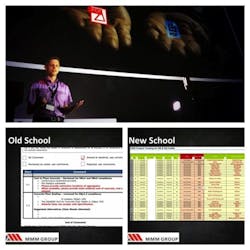What do LEED and black magic have in common? A project principal leverages PDFs to demystify it for us.
Editor's note: This is a sponsored article. All text and images were provided by the sponsor company.
I had the pleasure of playing Master of Ceremonies last week for the Bluebeam eXtreme Conference 2013. As part of my duties, I had to familiarize myself with all of the many customer presentations scheduled to take place throughout the day. One presentation in particular had me at “Manage LEED Projects.” Now, I remember the first time I learned about LEED—and let me tell you, it was more than a few years ago. LEED has become such a major part of our vernacular, I find I almost take it for granted that everyone is on board with LEED standards and knows how to best leverage them on their projects. However, what I find more accurate when talking to project teams is that LEED deals with so many complex and important sustainability issues, many firms rely on internal experts to help them navigate their projects.
But I digress. A Project Principal with Enermodal Engineering, which is a member of MMM Group and leading Energy and Environmental firm in Canada, put together a presentation on the ways in which the firm leverages data from 2D PDF takeoffs to run different energy calculations. As I clicked through the presentation with no narration, I was amazed at the level of detail he was able to get out of the PDF and the flexibility to dissect the information gathered. As the slides progressed, my jaw dropped closer to the floor and he had me hooked. I couldn’t wait to see this presentation live.
On the day of the conference, our first presenter, who happened to be a Superintendent working on a project for a major hotel chain, actually referenced LEED standards in his presentation. He made a comment that although his building was LEED-certified, the process of actually calculating the data to determine the best way to achieve those standards was, to him, black magic. Well, knowing that the LEED presentation was coming up, I knew we had the makings for a very interesting day ahead of us.
When the Project Principal with Enermodal took to the stage, the first statement he made was that he was there to demystify the process of managing a LEED project for us. (I saw our Superintendent perk up.) He broke down each of the steps involved in his process. First, he showed how he used PDF takeoff tools to pull measurement data from the PDF. Then, using custom columns and formulas he built into the PDF, he showed how he could take a single measurement and run multiple energy scenarios for multiple types of materials.
For instance, with just one takeoff of a room on the PDF, he could calculate the wattage needed to light that room. And, from the same measurement, he could select a different column to reflect a different material type to calculate air flow. He then linked specific parts of the PDF drawing to LEED specification guides, creating a clickable reference where he was able to add and track comments from reviews along the way. He then showed how he was able to export the data to Excel to do deeper calculations in addition to the on-the-fly calculations within the PDF itself. The beauty of this setup? Everything was digital. And because everything was digital, it was exportable and stood up to the United States Green Building Council’s rigorous audit processes. That meant a complete reduction in redundancy and duplicated efforts.
Now, inevitably, he was asked by the audience to share even more advice on how to manage LEED projects. He made one thing crystal clear: even with a simple tool like PDF, the benefits of leveraging digital solutions to manage a LEED project are great. It may take stellar math skills to achieve the desired end result, but magic is definitely not required.
About the Author

Sasha Reed
As Vice President of Strategic Development at Bluebeam, Inc., Sasha Reed collaborates with leaders in the architecture, engineering and construction industry to guide Bluebeam’s technology, partnerships and long-term goals. She joined Bluebeam in 2007 and co-created the Concierge Approach, a distinctly branded process of customer engagement, product feedback and solution delivery to which much of Bluebeam’s success is attributed, and which today is replicated at every organizational level.
Sasha is known industry-wide as a “conversation facilitator,” creating platforms for exchanges necessary to digitally advance the industry, including the BD+C Magazine Digital COM Blog, which she authors and manages. She’s been a featured presenter at numerous national and international conferences, including the 2014 Design-Build Institute of America (DBIA), Federal Project Delivery Symposium and NTI Danish BIM Conference. Sasha also co-chairs the Construction PDF Coalition, a grassroots effort to provide a common industry framework from which to create and maintain construction PDF documents, serves on the City College of San Francisco BIM Industry Council, and is Advisor to the Board of Direction for the National Institute of Building Sciences BuildingSMART Alliance.
